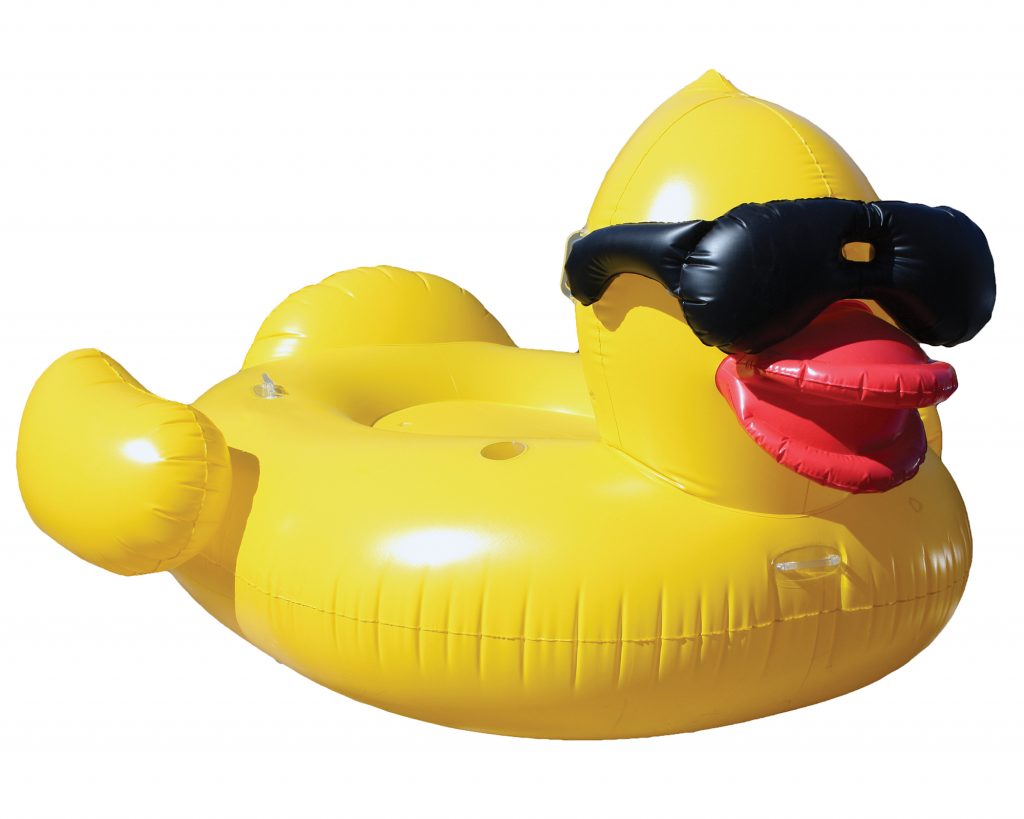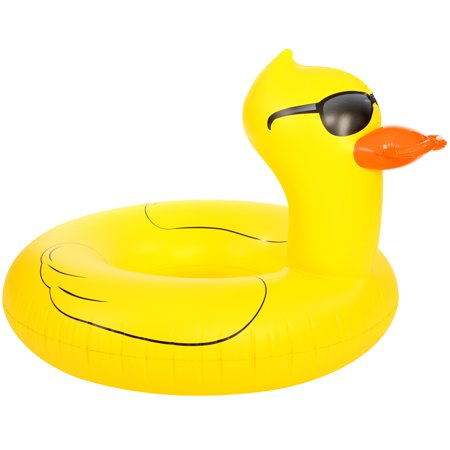
In 1988, Eric Schechter started GAME. At the time, GAME was focused on conducting fundraising activities. The fundraising concept was for individuals to “adopt” a small toy duck and then all the ducks would “race” on a waterway, such as the Salt River Canal or in New York Harbor. The person who had adopted the duck that finished first would win “a new car or prizes,” which had been donated. The sponsoring organization would then retain all the “adoption” fees.
Hoping to prevent knockoffs, Schechter realized he needed to “brand” or make GAME’s races “unique.” “One of the ways to do that was the duck itself.” Thus, Schechter and a few other individuals designed a unique plastic duck to use in the fundraising activities. Schechter and his collaborators designed a small duck from “scratch.” GAME’s original duck was similar to the familiar Rubber Duckie of Sesame Street fame with one crucial alteration: sunglasses. As explained by Schechter, the sunglasses served no functional purpose. Rather, the sunglasses were merely to differentiate GAME’s duck from other similar ducks already available in the market.
GAME experienced great success in its fundraising business. In 2001, a major retailer approached GAME and asked “to take the duck and make it into some pool products.” That inquiry resulted in GAME producing a few products, such as a “pool-dispensing chlorinator” with the distinctive GAME duck on the top. In 2012 or 2013, other retailers asked GAME to make a large inflatable in the shape of GAME’s duck. In 2015, GAME produced what it calls the “Giant Inflatable Derby Duck.” That product was offered for sale in 2016 and it became an immediate hit. The Derby Duck is yellow and has a red bill, which is open. The Derby Duck is a “flatbed float” which means there is a flat surface where individuals can sit or lie down without touching the water.
GAME has sold tens of thousands of its Derby Duck through numerous retailers. The Derby Duck has appeared in the press and in viral videos. When purchasing the Derby Duck, consumers encounter either the product box or two-dimensional pictures. Consumers usually do not see the Derby Duck inflated prior to purchasing. GAME owns various copyrights and trademarks involving a duck wearing sunglasses. GAME has devoted considerable resources in promoting, advertising, and marketing its products and services using its trademarks. GAME registered the Derby Duck with the United States Copyright Office. That Copyright is titled “Giant Inflatable Derby Duck.” A few years after the Derby Duck was first sold, competitors began to emerge.
Defendant Justin Ligeri was responsible for production of one of the Derby Duck’s competitors. Ligeri is the owner of Defendants Kangaroo and Yagoozon, Inc. Ligeri and Kangaroo experienced substantial success selling products on Amazon. At one point, Ligeri offered live seminars to teach other individuals how to successfully sell products on Amazon. In advertising those seminars, Ligeri very confidently appeared in a video where he presented his business model. What he would enlighten others to do was to “create a product for Amazon that people are looking for already.” In practice, it was clear that Ligeri and his companies would identify successful products on Amazon and then make slightly different versions of those products without apparent concern about possible intellectual property violations.
Bernard Oliver, Kangaroo’s product designer, did not have time to investigate intellectual property rights because Kangaroo was operated “like a sweatshop” where he “worked all day” and only left when he was “exhausted.” In late 2015 or early 2016, it has been decided that Kangaroo should manufacture “novelty pool floats.” Kangaroo’s executive looked at the available pool floats and discovered four duck pool floats sold by four different companies.
Oliver has been instructed to “create the design of a pool float in the form of a yellow duck with sunglasses but make it different from the yellow duck pool floats” already on the market. Oliver designed the new pool float and Kangaroo manufactured its own duck-wearing-sunglasses pool float. In other words, Oliver had the Derby Duck when designing Kangaroo’s duck and, to some extent, modeled Kangaroo’s duck after the Derby Duck. Oliver did not, however, slavishly copy the Derby Duck. Thus, while there are some similarities, there are also significant differences.

Sometime in 2016, Kangaroo and Yagoozon began selling their duck-wearing-sunglasses float on Amazon. However, GAME was not able to present evidence establishing how Kangaroo’s duck was listed on Amazon because the information was destroyed or was otherwise unavailable. Thus, it is unknown whether Kangaroo’s Amazon listing included a picture of the box or merely displayed pictures of the duck. It is also unknown how prominently Kangaroo identified itself in the listing. In short, the Court has no material and admissible evidence of how Kangaroo marketed its duck or how consumers encountered the Kangaroo duck.
Around January 2017, GAME saw Kangaroo’s duck listed for sale on Amazon. GAME complained to Amazon and Amazon immediately removed the listing. GAME also wrote to Kangaroo and claimed Kangaroo had “been selling a strikingly similar, knock-off version” of the Derby Duck. According to GAME, Kangaroo’s duck had “virtually the same appearance as” the Derby Duck. GAME requested Kangaroo “immediately stop all sales and distribution” of its duck. It is unclear whether Kangaroo responded to that letter but GAME filed the present suit a few days later. There was no evidence at trial that Kangaroo continued to sell its duck.
Pursuant to the operative complaint, GAME believes Kangaroo’s duck infringes its copyright for the Derby Duck. GAME also believes Kangaroo has committed trademark infringement as well as federal and common law unfair competition. To prevail on its copyright infringement action, GAME needed to prove two things: (1) that it owns a valid copyright in the Derby Duck and (2) Defendants copied protected elements of the Derby Duck. The parties stipulated that GAME owns a valid copyright, leaving only the second element at issue. “The second element has two distinct components: ‘copying’ and ‘unlawful appropriation.’” The evidence at trial established Kangaroo “copied” the Derby Duck when designing its own duck. That evidence is sufficient to satisfy the “copying” requirement.
Contrary to GAME’s position at trial, the fact that Kangaroo copied the Derby Duck does not establish liability. Even once GAME established “copying,” it still had to prove “unlawful appropriation.” “To prove unlawful appropriation the similarities between the two works must be “‘substantial’ and they must involve protected elements of the plaintiff’s work.” This requires “a two-part analysis consisting of the ‘extrinsic test’ and the ‘intrinsic test.’” To prevail, GAME had to “prove substantial similarity under both tests.”
“The extrinsic test assesses the objective similarities of the two works, focusing only on the protectable elements of the plaintiff’s expression.” In conducting this test, the Court must “‘filter out’ the unprotectable elements of the plaintiff’s work” and then compare the protectable elements in the plaintiff’s work with the “corresponding elements of the defendant’s work to assess similarities in the objective details of the works.” In the present case, GAME’s copyright cannot prevent others from depicting yellow ducks, with a bill, wings, a tail, and a crest on the head. All of those attributes are found on ducks in nature.
Moreover, the general design and coloring of the duck has become a “stock or standard feature.” There are very few protectable elements in the Derby Duck. The parties have focused on the addition of sunglasses as the crucial protectable element. And the Court agrees that the sunglasses are the key protectable element of the Derby Duck. But even there, GAME’s copyright provides no protection to the idea of a duck float wearing sunglasses. Rather, GAME’s copyright only protects the particular expression of that idea. That is, GAME is entitled to protection only for the way it expressed the idea of a duck wearing sunglasses.
The Court’s task is to determine whether the two expressions of the sunglasses-on-a-duck idea are so similar that “the ordinary observer, unless he set out to detect the disparities, would be disposed to overlook them.” When confronted with the two ducks, and focusing on the sunglasses, there are a few striking differences. The sunglasses on the Derby Duck consist of a double bridge, are solid black, and most importantly are separately inflatable. The fact that the sunglasses are inflatable make the sunglasses a very prominent feature of the Derby Duck. By contrast, the sunglasses on the Kangaroo duck have a single bridge, are not solid black, and are merely painted on the duck’s head.
An “ordinary observer” confronted with the two works and focusing on the sunglasses would not be “disposed to overlook” these differences. While the Derby Duck and Kangaroo’s duck undoubtedly share the general idea or concept of a duck wearing sunglasses, GAME “cannot claim an exclusive right to ideas or concepts at that level of generality.” The similarity of the protectable elements is not enough for GAME to pass the extrinsic test. Therefore, the Court need not continue and conduct the intrinsic test. But even if GAME had passed the extrinsic test, its copyright claim would fail.
The intrinsic test requires the Court conduct “a more holistic, subjective comparison of the works to determine whether they are substantially similar in ‘total concept and feel.’” The two ducks do not meet this test. The parties’ ducks are very different when compared with any care. The Derby Duck has a red bill that is open. Kangaroo’s duck has an orange bill that is closed. The Derby Duck is a flat float while Kangaroo’s duck is a ring float. Finally, the Derby Duck’s sunglasses are all black and exceptionally prominent. The Kangaroo duck’s sunglasses are only partially black and not especially prominent. In short, the “total concept and feel” of the two ducks preclude a finding of liability on the copyright claim.
Trademark Infringement
Here, GAME’s trademarks fall into the “descriptive” or “generic” category. The trademarks are just stylized versions of the underlying products. A consumer does not need to exercise any imagination to associate the mark with GAME’s products. Thus, GAME’s marks have relatively little conceptual strength. Here, there was no evidence offered that consumers associate GAME’s marks with GAME. But there was evidence that GAME has used its trademarks in advertising and had a substantial amount of sales. That advertising and sales mean GAME’s marks have some “commercial strength” but the absence of any indication that consumers recognize the mark undercuts that strength to a significant degree. On balance, the lack of conceptual strength and the absence of any meaningful evidence of consumer recognition (i.e., limited commercial strength) means the “strength of the mark” factor weighs in favor of Kangaroo.
While the products are related, there is insufficient evidence to determine whether the manner in which the products were presented or advertised would have caused consumers to assume there was an association between GAME and Kangaroo. Even though more factors support GAME than Kangaroo, evaluating the factors as a whole, and in light of all the other evidence, GAME has not established a probability of confusion. To be sure, there is some “possibility” of confusion. But that is not enough. The products and their boxes are sufficiently different such that consumers would not be confused into concluding Kangaroo’s product were manufactured by GAME. The trademark infringement claim fails.
GAME has not established by a preponderance of the evidence that Defendants committed copyright infringement, trademark infringement, or unfair competition under federal or Arizona law.